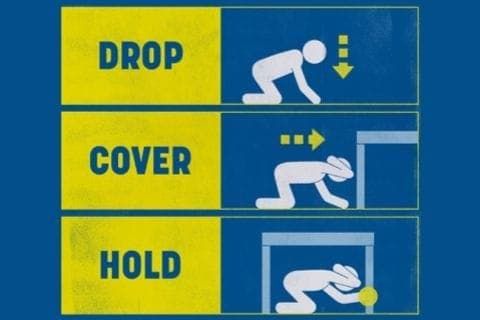Earthquake education for under sixes
Published on Wednesday, 16 October 2019
Last updated on Tuesday, 31 December 2019

Early childhood education (ECE) services teach youngsters many of the skills they need to navigate life's ups and downs, and when it comes to earthquakes, educators play an active role in helping young children understand quakes and protect themselves in an emergency.
The government encourages ECE services to practice correct earthquake responses with children, and the ShakeOut national earthquake drill and tsunami hīkoi teaches all New Zealanders what to do when a natural disaster strikes.
This year's ShakeOut is happening tomorrow Thursday, 17 October at 1.30pm, so let's see how ECE services prepare children for earthquakes and what the ShakeOut drill involves.
How do educators teach under sixes about earthquakes?
Earthquakes are unsettling at all ages and when it comes to young children, the idea of earth moving under their feet can be particularly frightening. For this reason, the government recommends that educators talk about earthquakes before they happen, ease children's concerns, and teach them practical quake-response skills.
At ECE services, educators will:
- Explain what an earthquake is and what to expect (e.g. shaking ground, rumbling noises, moving/falling objects and possible aftershocks)
- Encourage children to ask questions and communicate their feelings by talking or drawing
- Remind youngsters that earthquakes can be scary for everyone, but that people will be around to help and things will get better
- Teach children how to respond if the ground starts to shake, rattle and roll
What should children and educators do if there's an earthquake?
When a quake happens, the government says, 'You have to act quickly and protect yourself from things that might fall on you.'
The correct response is to Drop, Cover and Hold, which means that all ages should:
- Drop to their hands and knees.
- Cover their head and neck (and whole body if possible) under a sturdy table or desk. If there's no shelter within a few steps of them, people should cover their head and neck with their arms and hands.
- Hold on to their shelter (or head- and neck-protecting position) until the shaking stops. If their shelter shifts, people should move with it.
To convey this message to young children, the government has developed the Turtle Safe song and video, which makes the Drop, Cover and Hold response preschooler-friendly:
- If inside, it tells children to, 'Get under a table and hold on tight,' then stay there until the shaking stops and a grown-up says it's safe to come out.
- If there are no tables handy or they’re outside, children should, ‘Crouch on the ground and cover [their] head, just like a turtle tucked up in bed.'
There is a focus on children responding quickly when the earth begins to shake, understanding that there will be lots of people around to help and practising the earthquake drill several times with educators.
The government's 'What's The Plan, Stan?' activity pages are also a fun way to familiarise preschoolers with the Drop, Cover, Hold response, and for older kids, there are lots of online games to help them learn about emergency situations.
What does the ShakeOut involve?
This national drill reinforces what has been learnt at ECE services and teaches all New Zealanders the correct actions to take before, during and after an earthquake and tsunami:
- Before the ShakeOut, Kiwis are encouraged to learn about the earthquake and tsunami risks in their area and around the country. Those in coastal areas should research tsunami evacuation zones and plan their tsunami hīkoi (evacuation).
- On 17 October at 1.30pm, it's time to do the Drop, Cover and Hold drill for 30 to 60 seconds. Those in a tsunami evacuation zone will also practice their tsunami hīkoi and walk along the evacuation route, inland or to higher ground.
- After the drill, there is the chance for educators to talk about what everyone learnt from the ShakeOut and update to the ECE service's emergency plans, if necessary.
It's natural for children to feel rattled by the prospect of an earthquake or other natural disaster, but parents can rest assured that educators are focused on making under sixes feel safe, secure and prepared for any bumps along the road.
Further reading
How Early Childhood Education Services Support Young Children In The Wake Of Trauma
Related Articles

Your child's mental health
Most parents can spot a gunky eye or a grazed knee from a mile off, but when it comes to a youngster's mental health, it seems that many mums and dads are in the dark.

How early childhood education services support young children in the wake of trauma
Whether they are directly involved or feel the shockwaves reverberating in their community, young children can be strongly affected by traumatic events.

How to build resilience in your child
Supporting children to develop resilience and the ability to cope when things go wrong and overcome unexpected challenges in their life.
